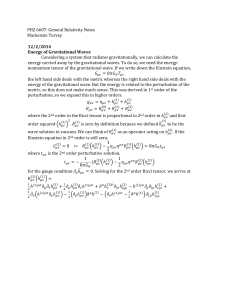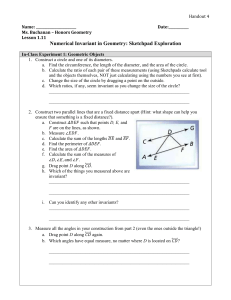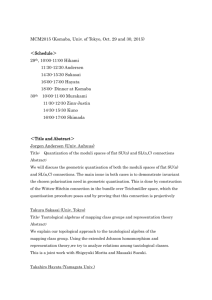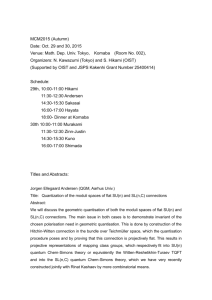A Particle System with Interlacing Pattern SPUR Final Paper, Summer 2013
advertisement
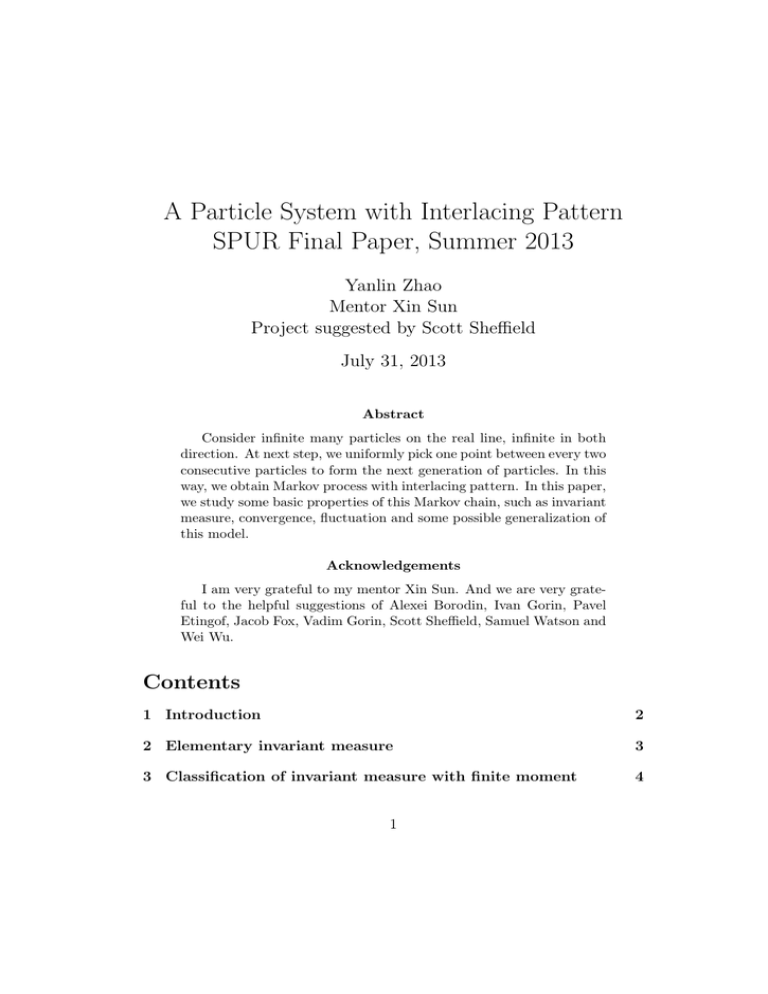
A Particle System with Interlacing Pattern
SPUR Final Paper, Summer 2013
Yanlin Zhao
Mentor Xin Sun
Project suggested by Scott Sheffield
July 31, 2013
Abstract
Consider infinite many particles on the real line, infinite in both
direction. At next step, we uniformly pick one point between every two
consecutive particles to form the next generation of particles. In this
way, we obtain Markov process with interlacing pattern. In this paper,
we study some basic properties of this Markov chain, such as invariant
measure, convergence, fluctuation and some possible generalization of
this model.
Acknowledgements
I am very grateful to my mentor Xin Sun. And we are very grateful to the helpful suggestions of Alexei Borodin, Ivan Gorin, Pavel
Etingof, Jacob Fox, Vadim Gorin, Scott Sheffield, Samuel Watson and
Wei Wu.
Contents
1 Introduction
2
2 Elementary invariant measure
3
3 Classification of invariant measure with finite moment
4
1
4 Convergence to invariant measure
6
5 Replace uniform distribution by general distribution on [0, 1]
6
6 Dynamics of a single particle
6.1 Invariant initial condition . . . . . . . . . . . . . . . . . . . .
6.2 Lattices initial condition . . . . . . . . . . . . . . . . . . . . .
7
7
8
1
Introduction
Interlacing pattern is a natural object in mathematics. It appears in representation theory as Gelfand-Tsetlin pattern, eigenvalues of sub-matrices
of Hermitian matrices etc. Correspondingly, there are some very important
random objects supported on interlacing patterns such as total asymmetric
exclusion process, some Schur and Macdonald process which lead to various
interacting particle systems, GUE corner process, lozenge tiling, bead model
etc. For the probability related to interlacing patterns, we refer to [1], [2],
[3], and reference therein. In this paper, we study a very natural Markov
chain under the interlacing condition.
Consider Markov chain Yn whose state space is 2R such that it is locally
finite and infinite in both direction. At time 0, Y0 = {x0i }i∈Z are infinite
points on R. If at time n, Yn = {xni }i∈Z , then Yn+1 = {xn+1
}i∈Z will satisfy
i
the two rules
Rule 1: xni < xn+1
< xni+1
i
n+1
Rule 2: xi
will be independently distributed according to U (xni , xni+1 ),
where U (xni , xni+1 ) is the uniform distribution in the open interval (xni , xni+1 ).
Denote Xin be the distribution of the gap between (xni , xni+1 ), Since it is
an Markov particle system, we are interested in two types of questions: equilibrium and dynamic. In the former direction, we give a family of ergodic
invariant measure and show that all the invariant under some moment assumption are convex combination of these measure. This type of result is
an analogue of that for exclusion process(see [4]). In the latter direction, we
study the convergence to equilibrium under certain initial condition and the
fluctuation of a single particle.
The paper is organized in the following way: in Section 2, we give a family
of invariant measure of this Markov dynamic. In Section 3 we employ moment
method to show that under certain moment condition, all the invariant mea-
2
sure are convex combination of the measure defined in Section 2. In Section
4 we show that the if the initial gaps form a stationary sequence satisfying
certain moment condition, then it converges to equilibrium. In Section 5, we
replace the uniform distribution by other distribution on [0, 1] and studied
similar questions. In Section 6, we first show that if under extremal invariant measure the trace of one particle is actually a Poisson process. Then we
study the fluctuation of on particle under the lattices initial condition. In
particular we give the order the variance of the position of a particle.
2
Elementary invariant measure
Theorem. If X(ρ) is a translational invariant measure which has independent and identically distributed gap Xi (ρ) whose density function is 4ρ2 xe−2ρx , (x >
0), then X(ρ) is a group of elementary invariant measure for the Markov process.
Proof. We prove that X(ρ) has the following properties:
1.Xi (ρ) are mutually independent under the Markov process
Since Xi (ρ) are independent,we want to prove that Xi1 (ρ) are independent.
It suffice to prove that any consecutive k gap of Xi1 are independent. Assume
f(t) is the characteristic function of Xi (ρ). Then
∫ +∞
1
f (t) =
eitx 4ρ2 xe−2ρx dx =
, c = −i/2ρ
(1 + ct)2
−∞
∫1
1
The characteristic function of Xi1 (ρ) is ( 0 f (tu) du)2 = f (t) = (1+ct)
2,c =
∫
1
2
1
1
−i/2ρ. The characteristic function of Xi +. . .+Xi+k−1 is ( 0 f (tu) du) f (t)k−1 =
f (t)k ,therefore Xi1 are independent. Thus Xi1 (ρ) are independent.
2.The distribution of the gap Xi (ρ) are invariant under the Markov process.
Assume U1 and U2 are any uniform distributions in [0,1] and f(t) is the characteristic function of Xi (ρ), then
∫1
∫1
1
1
2
f (t) = (1+ct)
2 , c = −i/2ρ, 0 f (tu) du = 1+ct f (t) = ( 0 f (tu) du)
Since Xi (ρ) are mutual independent under the Markov process.Hence, (1 −
U1 )Xi (ρ) + U2 Xi+1 (ρ) ∼ Xi (ρ)
3
3. X(ρ) is translational invariant under the Markov process.
Since X(ρ) is translational invariant, by the definition of the model,X 1 (ρ) is
translational invariant,therefore at any time n the measure is translational
invariant.
Thus,Xρ is a group of translational invariant invariant measure of constant
density ρ and the density function of the gap is 4ρ2 xe−2ρx , (x > 0).
3
Classification of invariant measure with finite moment
Theorem. Assume µ is an invariant measure. The distribution of the gap
is Xi , i ∈ Z. If Xi , i ∈ Z has finite moment EXij11 Xij22 . . . Xijnn ;
1
i1 , i2 , . . . , in ∈ Z, j1 , j2 , . . . , jn ∈ N and ∃ constant c,s.t.lim(E(Xi )k /k!) k <
c,then µ is a convex combination of X(ρ) of finite moment.
Lemma: If an invariant measure with gap distribution Xi has finite moment, then for any distinct i1 , i2 , . . . , in ∈ Z, and ∀k, j1 , j2 , . . . , jn ∈ N, j1 +
n +1)!
j2 + . . . + jn = k, ∃Ak ∈ R, s.t. EXij11 Xij22 . . . Xijnn = (j1 +1)!(j2 +1)!...(j
Ak
2k
Proof. Assume X0i = X0 is the distribution containing 0. For k=1,Since X01
is either generated by X0 , X1 (meansX0 = (1 − U1 )X0 + U2 X1 ) or X−1 , X0 .
Denote A = X0 is generated byX0 , X1 ,then we have 0 < P (A) < 1(if P(A)=0
or 1,then it can’t be an invariant measure).Since X0 is independent with Xi
when i → ∞.Then as |i| → ∞,since EXi is finite, we must have
EXi + EXi+1
EXi + EXi−1
) = lim(EXi+1 −
)=0
2
2
Hence, lim(EXi+1 − EXi ) = 0
Therefore, ∀² > 0, ∃M > 0, s.t.|EXi − EXi+1 | < ², for any|i| > M.
lim(EXi −
Since X0 is arbitrarily chosen, if we choose j and k, s.t. j−i > M, k−i < −M ,
then we can conclude that |EXi − EXi+1 | < ² for any i and ²,thus we let
A1 = EXi , ∀i ∈ Z
For k > 1 , set Yij11 Yij22 . . . Yijnn = 2k /(j1 +1)!(j2 +1)! . . . (jn +1)!EXij11 Xij22 . . . Xijnn
Then we only have to prove that for any distinct i1 , i2 , . . . , in ∈ Z, and
∀k, j1 , j2 , . . . , jn ∈ N, j1 + j2 + . . . + jn = k, Yij11 Yij22 . . . Yijnn are equal.
4
Similar to k=1, ∃M > 0,s.t. when |i1 |, |i2 |, . . . , |ik | > M
lim(EXi1 Xi2 . . . Xik −E((1−U1 )Xi1 +U2 Xi1 +1 ) . . . ((1−Uk )Xik +Uk+1 Xik +1 ))
= lim(EXi1 +1 Xi2 +1 . . . Xik +1 − E((1 − U1 )Xi1 + U2 Xi1 +1 ) . . . ((1 − Uk )Xik +
Uk+1 Xik +1 )) = 0
Therefore,similar to k=1, we can conclude thatEXi1 Xi2 . . . Xik = EXi1 +1 Xi2 +1 . . . Xik +1
= E((1 − U1 )Xi1 + U2 Xi1 +1 ) . . . ((1 − Uk )Xik + Uk+1 Xik +1 )
= E((1 − U1 )Xi1 −1 + U2 Xi1 ) . . . ((1 − Uk )Xik −1 + Uk+1 Xik )
Therefore,∃aj1 j2 ...jk , bj1 j2 ...jk ∈ R, s.t.
Yi1∑
Yi2 . . . Yik = Yi1 +1 Yi2 +1 . . . Yik +1
= ∑jt =it ,it +1;t=1,2,...,k aj1 j2 ...jk Yj1 Yj2 . . . Yjk
= jt =it ,it −1;t=1,2,...,k bj1 j2 ...jk Yj1 Yj2 . . . Yjk
− −(1)
If we let Xi ∼ Xi (ρ), then EXij11 Xij22 . . . Xijnn = EXij11 EXij22 . . . EXijnn = 2k /(j1 +
1)!(j2 + 1)! . . . (jn + 1)!
Therefore, we have Yi1 Yi2 . . . Yik = 1.
∑
Since aj1 j2 ...jk , bj1 j2 ...jk are only related to U ,therefore by (1) we have aj1 j2 ...jk =
∑
bj1 j2 ...jk = 1. − −(2)
i!j!
∗ (i+j+1)!
Y i+j =
Since E((1 − U )X)i (U X)j = E(1 − U )i U j EX i+j = (i+j+1)!
2i+j
i!j!
Y i+j
2i+j
1 (i+1)! i 1 (j+1)! j i!j!
E((1 − U )X)i E(U X)j = i+1
Y j+1 2j Y 2i+j Y i+j Therefore,after we
2i
substitute EXij11 Xij22 . . . Xijnn by Yij11 Yij22 . . . Yijnn , the coefficient aj1 j2 ...jk , bj1 j2 ...jk
1
are all equal,and by (2) they are equal to (j1 +1)(j2 +1)...(j
–(3).
k +1)
∑
j1 j2
jn
1
Next by(1)(2)(3)we have Yij11 Yij22 . . . Yijnn = (j1 +1)(j2 +1)...(j
jt =it ,it +1;t=1,2,...,n Yi1 Yi2 . . . Yin =
n +1)
∑
j1 j2
jn
1
jt =it ,it −1;t=1,2,...,n Yi1 Yi2 . . . Yin − −(∗),it suffice to prove
(j1 +1)(j2 +1)...(jn +1)
that Yij11 Yij22 . . . Yijnn are equal:
We prove by contradiction:If Yij11 Yij22 . . . Yijnn are not equal,since Yij11 Yij22 . . . Yijnn
are finite.
Set A(m) = {Yij11 Yij22 . . . Yijnn ||in −i1 | = m},assume a(m) = max{a ∈ A(m)}, b(m) =
min{b ∈ A(m)},then∃ minimal t > 0, s.t., a(t+1)−a(t) > ² or b(t+1)−b(t) <
−².
Assume we have a(t + 1) − a(t) > ²(For b(t + 1) − b(t) < −²,the proof is simij0 j0
j0
lar), then by (*) either ∃(jn0 + j10 ) < (jn + j1 ), Yi0 1 Yi0 2 . . . Yi0nn > Yij11 Yij22 . . . Yijnn
2
1
or a(t + 2) − a(t + 1) > ² (if not we have 0 > (j2 + 1) . . . (jn−1 + 1)² − (j2 +
1) . . . (jn−1 + 1)² = 0 which leads to a contradiction.)
Since jn + j1 ≤ kand (a(t + 2) − a(t + 1)) ≥ k2 (a(t + 1) − a(t)) always holds,
therefore limm→∞ a(m) = Yij11 Yij22 . . . Yijnn → ∞,when |in − i1 | → ∞
5
, which leads to a contradiction with finite moment. Thus for any distinct
i1 , i2 , . . . , in ∈ Z, and ∀k, j1 , j2 , . . . , jn ∈ N, j1 +j2 +. . .+jn = k, Yij11 Yij22 . . . Yijnn are
equal.
i
Proof of the theorem: By lemma,if we set Yi ∼ XX0 (ρ)
.Then we have EYij11 Yij22 . . . Yijnn =
1
Ak (j1 + j2 + . . . + jn = k).Since ∃ constant c,s.t.lim(E(Xi )k /k!) k < c, therefore Yi equal to the same distribution Y . Xi ∼ Y X0 (ρ),so the gap Xi is a
convex combination of Xi (ρ). Now we only have to prove that the distribution of 0 in X0 is unique,then µ is a convex combination of X(ρ). Assume X’ is the distribution of the gap between 0 and x1 . Then, we have
X 0 = X 0 + U1 X1 , ifX 0 < U0 X0 ; X 0 − U0 X0 , ifX 0 > U0 X0
Therefore, (X0 , X 0 )forms a Markov chain and (X0 , X 0 ) is ergodic on R*R.
Thus the invariant joint distribution of the Markov process is unique.
4
Convergence to invariant measure
Theorem. Consider initial measure µ which has independent and identical
distributed gap Xi , i ∈ Z. If the initial gap Xi has finite moment E(Xi )m , m ∈
N, then µ converge to an invariant measure.
Proof. We only have to prove that for any m ∈ N, lim E(Xi )m ∃ and ∃ con1
stant c,s.t.lim(E(Xi )k /k!) k < c.
We prove by induction on m thatan = lim E(Xi )n ∃.
First, E(Xij ) = E(Xi ) exist. Since µ is transitional invariant, we set ρ =
1/EXi .
Assume for m < n, an = lim E(Xi )n = (n+1)!
,then for m = n, since E(Xij ) are
(2ρ)n
independent.(EXij )n = E((1 − U1 )X1 + U2 X2 )n =
1
1
E(X1 )n + n+1
E(X2 )n +
n+1
n!(n−1)
(2ρ)n
Therefore,lim E(Xi )n = (n+1)!
(2ρ)n
Thus, µ converge to X(ρ) which is an invariant measure.
5
Replace uniform distribution by general distribution on [0, 1]
Theorem. If U is a general distribution on [0, 1], EU 2 +E(1−U )2 6= 1, then
∃ invariant measure of the Markov process and all invariant measure are the
6
convex combination of a group of particular invariant measure X(U, ρ).
Proof. In section 3, we have prove that if Xi is the gap of invariant measure X(U, ρ), then for any distinct i1 , i2 , . . . , in ∈ Z, and ∀k, j1 , j2 , . . . , jn ∈
N∗, j1 + j2 + . . . + jn = k
IfEXij11 Xij22 . . . Xijnn ∃, then ∃Ak ∈ R, s.t. E(Xi1 /X(U, 1))j1 (Xi2 /X(U, 1))j2 . . . X(in X(U, 1))jn =
Ak
Therefore, consider the k-order moment EX1j1 X2j2 . . . Xnjn . Since EX1j1 X2j2 . . . Xnjn can
be written as the linear combination of EX1j1 X2j2 . . . Xnjn , j1 +j2 +. . .+jn = k.
If we assume vector v=(EX1j1 X2j2 . . . Xnjn , j1 + j2 + . . . + jn = k), then we have
v=Av, A is a |v| ∗ |v| matrix. We now have to prove that the linear equations have a non-zero solution. In section 4,since EU 2 + E(1 − U )2 6= 1 ⇒
EU n + E(1 − U )n 6= 1. Hence the initial coefficient of EX1j1 X2j2 . . . Xnjn , j1 +
j2 + . . . + jn = k = 1 − EU n − E(1 − U )n > 0. We have prove that if
we start from an initial measure µ which has i.i.d gap distribution Xi , then
lim EX1j1 X2j2 . . . Xnjn , j1 + j2 + . . . + jn = k∃. Therefore, the solution of the
linear equations exist and must be a distribution of the limit measure which
is also an invariant measure. Thus, all invariant measure are the convex
combination of a group of particular invariant measure X(U, ρ) satisfying
EX n = E((1−U1 )X1 +U2 X2 )n ⇔ X(U, ρ) = (1−U1 )X(U, ρ)+U2 X(U, ρ).
6
6.1
Dynamics of a single particle
Invariant initial condition
Theorem. If we start from an invariant measure X(ρ), then the fluctuation
of a particular point xn0 is a Poisson process.
Proof. Assume x00 = 0. Then xn0 = U0 X00 + U1 X01 + . . . + Un X0n . Ui are
independent uniform distribution on [0, 1], suppose g(t) is the characteristic
function of Ui X0i .
∫ 1
g(t) =
f (tu) du = 1/(1 − i/2ρ)
0
Therefore,Ui X0i have the same distribution which is an exponential distribution with density function 2ρe−2ρx , x > 0. We want to prove that Ui X0i are
mutually independent: In section 2,we have found that f (t) = g(t)2 and Xin
are mutually independent, therefore Ui X0i is independent with (1 − Ui )X0i .
7
Hence, U0 X00 is independent with U1 X01 = U1 ((1 − U0 )X00 + U00 X10 ). Assume
for m¡n U0 X00 , . . . , Um X0m are mutually independent. Then for m=n, since
0
X1n−1 ), U0 X00 , . . . , Un−1 X0n−1 are indepenUn X0n = Un ((1 − Un−1 )X0n−1 + Un−1
0
, Un Similarly we have Un−1 X0n−1 and (1 − Un−1 )X0n−1
dent with X1n−1 , Un−1
are independent.Thus, U0 X00 , . . . , Un X0n are mutually independent Therefore
xn
xn0 is a Poisson process. Thus we have σin ∼ normal distribution.
6.2
Lattices initial condition
In this section, we study the dynamic of the interlacing particle system under
the lattice initial condition,which means Y0 = {xi = i, i = 0, 1, . . . , n}.
Theorem. Assume the distribution is U andEU = a, EU 2 = b, a2 < b ≤ a,
V ar(xn )
We have there exists constant c1 , c2 , s.t., 0 < c1 < n/ log0n < c2
n−1
Proof. Assume σn2 is the deviation of xn = xni , x = xin−1 , y = xi+1
.EU =
2
n
a, EU = b Ex = an
xn = x + U (y − x), x0 = x + (y − x)/2
Then we have σn2 = E(x + U (y − x))2 − (an)2
= (1 − 2a + b)Ex2 + bEy 2 + 2(a − b)Exy − (an)2
2
2
+ (a(n − 1) + 1)2 ] +
+ (a(n − 1))2 ] + b[σn−1
= (1 − 2a + b + 2(a − b))[σn−1
2(a − b)Ex(y − x) − (an)2
2
+ (a2 + b − 2ab) + 2(a − b)E(x0 (y − x) − an) − (a − b)E(y − x)2 (1)
= σn−1
Substitute a by 1-a,b by 1-2a+b,then U is change to 1-U: due to symmetry
we also have:
2
+((1−a)2 +b−2(1−a)b)+2(a−b)E(y 0 (y−x)−an)−(a−b)E(y−x)2
σn2 = σn−1
(2)
2
+ (a − a2 ) − (a − b)E(y − x)2
By(1)(2)⇒ σn2 = σn−1
2
2
+ (a − a2 ) − (a − b)EX0n−1 − −(3)
= σn−1
8
2
we have:
Set aki = EX0k Xik ,then EX0n−1 = an−1
0
aik+1
= (1 − 2(a − b))ak0 + 2(a − a2 )ak1
ak+1
0
a1k+1 = (1 − a − b)ak0 + (1 − 2a + 2a2 )ak1 + (a − a2 )ak2
= (a − a2 )aki−1 + (1 − 2a + 2a2 )aki + (a − a2 )aki+1 , i > 1
Since∀i, a0i = 1,Hence,assumean0 = An a00 + Bn a01 + . . . = An + Bn + . . . (A0 =
1, B0 = 0)
Set Sn = An + Bn + . . . Thenan0 = Sn and Sn = Sn−1 + (2b − 2a2 )An−1 − (b −
a2 )Bn−1 By(*),An = (1 − 2(a − b))An−1 + (a − b)Bn−1 ⇒
2
= Sn−1 =
EY0n−1 = an−1
0
a − a2 b − a2
−
An−1
a−b
a−b
(4)
2
+ (b − a2 )An−1
By(3)(4)⇒ σn2 = σn−1
n−1
∑
Ak
⇒ σn2 = (b − a2 )
k=1
Thus, we only have to find the estimation of tn−1 =
n−1
∑
Ak By(*), An is
k=1
derived by two sequences:
1 − 2b
(B0 An + B1 An−1 + . . . + Bn A0 )
4
= 1/2Bn+1 + 1/16(B0 Bn + B1 Bn−1 + . . . + Bn B0 )
An+2 = 2bAn+1 +
Bn+2
A0 = 1, A1 = 1 − 2(a − b), B0 = 0, B1 = 2(a − a2 ) First it is easily to prove
n
< c2
that ∃constant c1 , c2 , s.t., c1 < 4−B
1/n
n−1
P
Ak
Therefore,∃constant c1 , c2 , s.t.c1 < the sum of allk=1the entries ofA−1 < c2
where A is
1 1/2 . . .
1/n
0
1 . . . 1/(n − 1)
··· ··· ···
···
0
0 ...
1
Set J=
0
1
0 ... 0
0
0
1 ... 0
··· ··· ··· ··· ···
0
0
0 ... 0
9
Then the sum all the entries of A−1 is the coefficient of x on (nf (x) −
x
f 0 (x)), f (x) = − log(1−x)
,which is ∼ logn n
References
[1] Alexei Borodin and Ivan Corwin. Macdonald processes. Probability Theory and Related Fields, pages 1–176, 2011.
[2] Cédric Boutillier. The bead model and limit behaviors of dimer models.
The Annals of Probability, 37(1):107–142, 2009.
[3] Patrik L Ferrari. Dimers and orthogonal polynomials: connections with
random matrices. arXiv preprint arXiv:1004.3212, 2010.
[4] Thomas M Liggett. Interacting particle systems. Springer, 2005.
10





